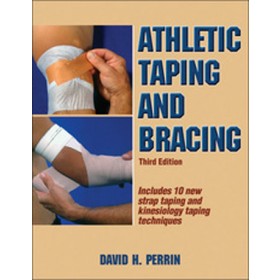Details
Athletic Taping and Bracing, 3rd Edition (Electronic Download)
SKU: 801E
By David H. Perrin, PhD, ATC.
Now Available as an Electronic Download Course!
This course is offered in cooperation with Human Kinetics and utilizes the textbook, "Athletic Taping and Bracing, 3rd Ed and the video collection “Sport Taping Basics”, 2nd Ed. With its concise anatomical descriptions and detailed anatomical illustrations similar to those normally found in advanced texts on anatomy, the included textbook clearly highlights the mechanisms of injury that are crucial for understanding effective taping and bracing. The text thoroughly discusses and illustrates the general principles of taping and bracing for each major joint and body region. It also contains step-by-step instructions for 46 taping and wrapping procedures, including elastic kinesiology taping and rigid strap taping techniques for gastrocnemius strains, Achilles tendinitis, and arch problems; knee, quadriceps, and hip problems; shoulder and elbow hyperextension laxity; epicondylitis; and wrist and hand issues.
The video files bring the book to life by visually demonstrating 32 specific taping procedures, each being shown in its entirety without disruption. The taping procedure is then shown again to highlight the key steps of the procedure, and includes close-ups and correct positioning of the athletic trainer and athlete, making the demonstrations easy to follow. Perrin also gives advice on the use of appropriate taping equipment for specific injuries, including when to use elastic or inelastic tape, adhesive spray, moleskin, anchor strips, friction pads, and underwrap. He discusses alternative taping techniques to use for various injuries—for example, how to tape an ankle sprain with an inversion versus an eversion—so the correct procedure can be applied.
With this course, students will learn the evidence-based foundations and techniques of taping and bracing, as well as how taping and bracing can aid an athlete’s total rehabilitation. The coverage of rehabilitation exercises as well as prevention will help readers become more effective health care providers for athletes and other active people with musculoskeletal injuries and problems.
Order this product and it will be available to you immediately after purchase for electronic download in the “My Downloads” section of your account after you have logged in. The download files will require Adobe Acrobat Reader to open. If you do not have Adobe Acrobat installed, you may download it at no charge from Adobe.com.
Course Length: 10.0 contact hours
Instructional Level: Beginner/Intermediate
This package includes the pdf reading and testing materials and access to the online video files. We apologize, but the hard copy version of this course is out-of-print and no longer available.
Athletic Taping and Bracing
Course Goals:
This course is intended to instruct the student through self-paced study of techniques of athletic taping and bracing for the upper and lower extremity.
Student Objectives:
At the end of this course the student will be able to:
1. Identify the role of taping and bracing in athletics
2. Differentiate between elastic tape, non elastic tape, underwrap, elastic wraps, rigid strapping tape and elastic kinesiology tape and the advantages and disadvantages of each.
3. Understand 5 precautions for strap taping and kinesiology taping
4. Outline steps for the application of strapping tape
5. Outline steps for the application of kinesiology tape
6. Distinguish 3 criteria for returning an injured athlete to competition
7. Analyze the components of an injury assessment protocol
8. Recognize the principles of applying and removing tape from a patient
9. Distinguish the most common type of ankle sprain and taping procedures that can be used to stabilize ankle sprains
10. Select appropriate stretching and exercise activities for the ankle
11. Break down the taping procedures for Achilles tendon strains and tendonitis
12. Compare taping procedures for foot arch strains and plantar fasciitis
13. Compare taping procedures for foot arch support
14. Break down taping procedures for great toe sprains and heel contusions
15. Define “turf toe” and its method of injury
16. Outline the components of taping for the treatment of shin splints
17. Identify the 3 anatomical structures that form the “terrible triad” when injured.
18. Contrast taping procedures for medial and lateral collateral ligament support
19. Compare taping procedures for anterior and posterior cruciate ligament support
20. Distinguish taping procedures to stabilize knee hyperextension
21. Break down the McConnell taping procedures for patellofemoral support and correction
22. Differentiate between taping procedures for hip strains
23. Identify techniques to determine between adductor and hip flexor strains
24. Examine taping procedures for hamstring strains
25. Differentiate between techniques to determine strains of the medial or lateral hamstring
26. Explain methods of injury that can result in an acromioclavicular joint sprain
27. Differentiate between taping techniques for a shoulder sprain or shoulder instability
28. Compare taping techniques for elbow strains and collateral ligament instability
29. Distinguish taping techniques for elbow hyperextension prevention
30. Distinguish between taping techniques for elbow edpicondylitis
31. Identify taping techniques for wrist, thumb and finger sprains






